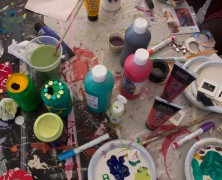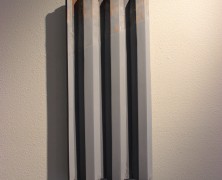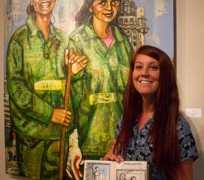Ranging from surreal photography to blind contour drawings of cute puppies, the pieces on the wall at IAC’s Gift Auction flowed seamlessly into the next, even though they were all made for reasons entirely personal to the artists.
What is a Gift?
posted by Amanda Tyler
The Gift Music and Art Festival takes place this weekend, on the nights of both Nov. 8-9. For free admission, students can create a gift of artwork to be given up for auction at a later date. So what exactly should this gift consist of? The crew behind the festival is accepting any medium of work, of any size or subject matter. So far, gifts have ranged from alternative process photographic prints to origami birds and intricately painted portraits. Music and film majors are welcomed to submit a gift in their genre also, provided that a CD or DVD of the work can be presented. All art will be accepted for admission, as long as it is evident that time, energy and thought has been put into the piece. When your work is complete, the gift can be be brought to the festival, where a crew member will exchange it for your entrance. Still stuck? Pictures below demonstrate a few examples of work made and materials used for a variety of gifts. For more information on the festival, check out this Jackalope article and the event Facebook...
Harvest Season
posted by Nicholas Beckman
“We didn’t want to curate something that seemed like an exhibition,” Luke Dorman explained in defense of his process curating Harvest, the studio art department’s 2nd annual juried art show. Dorman, along with Kelsy Waggaman, both graduates of the College of Santa Fe, were selected to judge and curate Harvest. On Thursday, Oct. 17, the two sat down for an open talk with anyone interested in learning more about their approach to the show. “The exhibition of the rejects,” or Salon de Refuses, is the first cluster of artwork seen when stepping into Fine Arts Gallery in the Southwest Annex. The salon, which was located in the rear of the exhibition during last year’s show, presents all of the works that were submitted to Harvest, but not accepted. The walls are filled with vibrant pieces of each artist’s individual talent, differing in both mediums and subject matter, but aesthetically stimulating when packed so closely together. They fool you into thinking that this is the show you came to see and, judging by the placement and variety in artwork, it is not that much of a stretch. You begin to realize then, after moving a little further into the room, that the selections that have been individually chosen and praised by the jurors are yet to come. The focus shifts from everything at once to one at a time. The 12 pieces selected were given room to breathe between one another with not a single exhibit resembling the next, yet they were all somehow related. You’ve already been shown the works that didn’t work together with all of the variables that go into a juried show, so you can gather that these pieces are meaningful and are all speaking to you thematically. In response to a student’s question asking if a specific theme was apparent to her and Dorman, Waggaman emphasized the importance of the viewer’s response rather than the jurors’ intent. “Do you see a theme?” she posed. At the Q&A with the jurors, students and faculty members, the majority of questions of which were centered around the purpose of the show, its layout in the space and the jurors’ ideas on juried shows in general. Dorman and Waggaman both agreed that, as former art students, it was difficult for them to say “no” to certain pieces that were truly remarkable by themselves, but didn’t work well next to other pieces. Waggaman described acceptance into the Salon as “a different kind of pride.” She also said that whenever her work wasn’t accepted to shows, she learned the most from those failures and it showed her how to improve her work for the next time. From embroidered shoes/socks on paper plates to a mimetic painting of two feuding foxes, all of the pieces in Harvest and the Salon played together to create a sense of place and acceptance. Both jurors worked independently at first in order to decide which ones they liked personally, then came together and collaborated with each other’s favorites. This bonding of different minds formed a cohesive collection of artwork that somehow worked together—despite lacking a specific...
Navigable Obstacles
posted by Brandon Ghigliotty
Tom Miller’s first exhibition at Zane Bennett Contemporary Art, Walling: Containing Architecture challenges the difficulties imposed by framing and claiming space, as well the implications of division. Perspective shifts from one side of the barrier to the other: On one side, hope and possibility; and on the other, denial and entropy. “Long Wall with Fix,” a floor sculpture that dominates the entrance of Zane Bennett Contemporary Art, bisects the cracked, striated concrete floor. Gallery goers navigated the wall in their own way, with many simply reaching over to shake Miller’s hand, rather than work their way around. This is an intended consequence and a result of Miller’s desire to thematically enact walling and distance through a barrier installation. Throughout the night, people seemed to gather on the side of the wall that faced the entrance. Its white face interrupted by raw plywood patchwork near the top. The front starkly contrasts the rear, its naval-gray neutral hue and tank trap trusses evident and imposing. One side stands clean, welcoming and projecting perfection, while the other feels militarized and built to task. The same materials—plywood, resin and paint—crafted for different evocative purposes. The work weaves through the gallery. A narrow stretch of hallway holds work that lies vertical in opposition to the long horizontal hall. Just before the path turns the hallway, “New Standard” appears. The perspective of the painting denotes two symmetrical swathes pulling away from the center, and each other, threatening to creep from its canvas and wrap around its privileged space. “Small Tower“ marks the beginning of the hall, both obstacle and observation tower, with a peg leg repair that replaces one of the four feet it rested upon. In the hall, a piece known as “Slice“ beckons observers closer. “Slice’s” top shows marred, exposed wood—forgotten or...
Alumni Profile
posted by Shayla Blatchford
Originally from New England, Erin Currier is currently a Santa Fe resident who graduated from the College of Santa Fe in 1997 with a BFA in Theater Design. As a child, Currier grew up drawing, painting and collaging alongside her mother, who was a huge influence on her. While working in a coffee shop, Currier was “struck by how much trash was thrown away every day.” It was the packaging and the overall aesthetic of these articles that caught her attention. She began to collect particular pieces of trash, which purposefully made their way into her collaged paintings of Buddhist deities and Taras. Within a year of graduating, Currier had her very first solo show in Taos. With great response, her work had made it to the cover of the newspaper and onto the radio. Since her debut, Currier has been able to follow her childhood dreams of making art and traveling the world. Over the years her work has “shifted from Easter spirituality to a much more outwardly sociopolitical bend.” Currier had a recent show at Blue Rain Gallery in Santa Fe, where she is a featured artist....






 Jackalope Magazine is the student magazine of Santa Fe University of Art and Design. Building on the interdisciplinary nature of our education, we aim to showcase the talent of our university and character of our city.
Jackalope Magazine is the student magazine of Santa Fe University of Art and Design. Building on the interdisciplinary nature of our education, we aim to showcase the talent of our university and character of our city.
Recent Comments